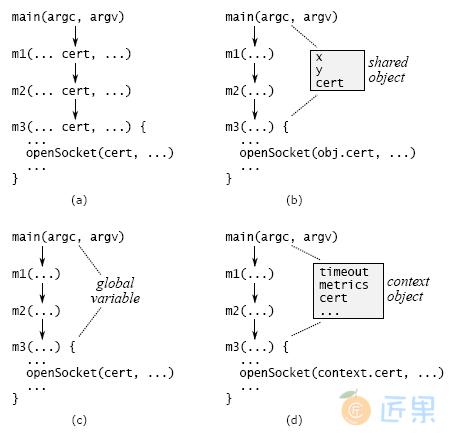跨层 API 复制的另一种形式是传递变量,该变量是通过一长串方法向下传递的变量。图 7.2(a)显示了数据中心服务的示例。命令行参数描述用于安全通信的证书。只有底层方法 m3 才需要此信息,该方法调用一个库方法来打开套接字,但是该信息会通过 main 和 m3 之间路径上的所有方法向下传递。cert 变量出现在每个中间方法的签名中。
传递变量增加了复杂性,因为它们强制所有中间方法知道它们的存在,即使这些方法对变量没有用处。此外,如果存在一个新变量(例如,最初构建的系统不支持证书,但是您后来决定添加该支持),则可能必须修改大量的接口和方法才能将变量传递给所有相关路径。
消除传递变量可能具有挑战性。一种方法是查看最顶层和最底层方法之间是否已共享对象。在图 7.2 的数据中心服务示例中,也许存在一个对象,其中包含有关网络通信的其他信息,这对于 main 和 m3 都是可用的。如果是这样,main 可以将证书信息存储在该对象中,因此不必通过通往 m3 的路径上的所有干预方法来传递证书(请参见图 7.2(b))。但是,如果存在这样的对象,则它本身可能是传递变量(m3 还将如何访问它?)。
另一种方法是将信息存储在全局变量中,如图 7.2(c)所示。这避免了将信息从一个方法传递到另一个方法的需要,但是全局变量几乎总是会产生其他问题。例如,全局变量使得不可能在同一过程中创建同一系统的两个独立实例,因为对全局变量的访问会发生冲突。在生产中似乎不太可能需要多个实例,但是它们通常在测试中很有用。
我最常使用的解决方案是引入一个上下文对象,如图 7.2(d)所示。上下文存储应用程序的所有全局状态(否则将是传递变量或全局变量的任何状态)。大多数应用程序在其全局状态下具有多个变量,这些变量表示诸如配置选项,共享子系统和性能计数器之类的内容。每个系统实例只有一个上下文对象。上下文允许系统的多个实例在单个进程中共存,每个实例都有自己的上下文。
不幸的是,在许多地方可能都需要上下文,因此它有可能成为传递变量。为了减少必须意识到的方法数量,可以将上下文的引用保存在系统的大多数主要对象中。在图 7.2(d)的示例中,包含 m3 的类将对上下文的引用作为实例变量存储在其对象中。创建新对象时,创建方法将从其对象中检索上下文引用,并将其传递给新对象的构造函数。使用这种方法,上下文随处可见,但在构造函数中仅作为显式参数出现。
图 7.2:处理传递变量的可能技术。在(a)中,证书通过方法 m1 和 m2 传递,即使它们不使用它也是如此。在(b)中,main 和 m3 具有对一个对象的共享访问权,因此可以将变量存储在此处,而不用将其传递给 m1 和 m2。在(c)中,cert 存储为全局变量。在(d)中,证书与其他系统范围的信息(例如超时值和性能计数器)一起存储在上下文对象中;对上下文的引用存储在其方法需要访问它的所有对象中。
上下文对象统一了所有系统全局信息的处理,并且不需要传递变量。如果需要添加新变量,则可以将其添加到上下文对象;除了上下文的构造函数和析构函数外,现有代码均不受影响。由于上下文全部存储在一个位置,因此上下文可以轻松识别和管理系统的全局状态。上下文也便于测试:测试代码可以通过修改上下文中的字段来更改应用程序的全局配置。如果系统使用传递变量,则实施此类更改将更加困难。
上下文远非理想的解决方案。存储在上下文中的变量具有全局变量的大多数缺点。例如,为什么存在特定变量或在何处使用特定变量可能并不明显。没有纪律,上下文会变成巨大的数据抓包,从而在整个系统中创建不明显的依赖关系。上下文也可能产生线程安全问题;避免问题的最佳方法是使上下文中的变量不可变。不幸的是,我没有找到比上下文更好的解决方案。
Another form of API duplication across layers is a pass-through variable, which is a variable that is passed down through a long chain of methods. Figure 7.2(a) shows an example from a datacenter service. A command-line argument describes certificates to use for secure communication. This information is only needed by a low-level method m3, which calls a library method to open a socket, but it is passed down through all the methods on the path between main and m3. The cert variable appears in the signature of each of the intermediate methods.
Pass-through variables add complexity because they force all of the intermediate methods to be aware of their existence, even though the methods have no use for the variables. Furthermore, if a new variable comes into existence (for example, a system is initially built without support for certificates, but you later decide to add that support), you may have to modify a large number of interfaces and methods to pass the variable through all of the relevant paths.
Eliminating pass-through variables can be challenging. One approach is to see if there is already an object shared between the topmost and bottommost methods. In the datacenter service example of Figure 7.2, perhaps there is an object containing other information about network communication, which is available to both main and m3. If so, main can store the certificate information in that object, so it needn’t be passed through all of the intervening methods on the path to m3 (see Figure 7.2(b)). However, if there is such an object, then it may itself be a pass-through variable (how else does m3 get access to it?).
Another approach is to store the information in a global variable, as in Figure 7.2(c). This avoids the need to pass the information from method to method, but global variables almost always create other problems. For example, global variables make it impossible to create two independent instances of the same system in the same process, since accesses to the global variables will conflict. It may seem unlikely that you would need multiple instances in production, but they are often useful in testing.
The solution I use most often is to introduce a context object as in Figure 7.2(d). A context stores all of the application’s global state (anything that would otherwise be a pass-through variable or global variable). Most applications have multiple variables in their global state, representing things such as configuration options, shared subsystems, and performance counters. There is one context object per instance of the system. The context allows multiple instances of the system to coexist in a single process, each with its own context.
Unfortunately, the context will probably be needed in many places, so it can potentially become a pass-through variable. To reduce the number of methods that must be aware of it, a reference to the context can be saved in most of the system’s major objects. In the example of Figure 7.2(d), the class containing m3 stores a reference to the context as an instance variable in its objects. When a new object is created, the creating method retrieves the context reference from its object and passes it to the constructor for the new object. With this approach, the context is available everywhere, but it only appears as an explicit argument in constructors.
Figure 7.2: Possible techniques for dealing with a pass-through variable. In (a), cert is passed through methods m1 and m2 even though they don’t use it. In (b), main and m3 have shared access to an object, so the variable can be stored there instead of passing it through m1 and m2. In (c), cert is stored as a global variable. In (d), cert is stored in a context object along with other system-wide information, such as a timeout value and performance counters; a reference to the context is stored in all objects whose methods need access to it.
The context object unifies the handling of all system-global information and eliminates the need for pass-through variables. If a new variable needs to be added, it can be added to the context object; no existing code is affected except for the constructor and destructor for the context. The context makes it easy to identify and manage the global state of the system, since it is all stored in one place. The context is also convenient for testing: test code can change the global configuration of the application by modifying fields in the context. It would be much more difficult to implement such changes if the system used pass-through variables.
Contexts are far from an ideal solution. The variables stored in a context have most of the disadvantages of global variables; for example, it may not be obvious why a particular variable is present, or where it is used. Without discipline, a context can turn into a huge grab-bag of data that creates nonobvious dependencies throughout the system. Contexts may also create thread-safety issues; the best way to avoid problems is for variables in a context to be immutable. Unfortunately, I haven’t found a better solution than contexts.
